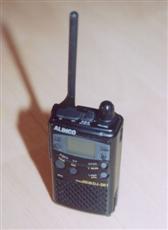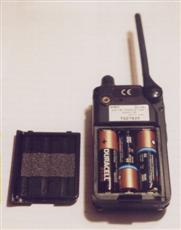About 12 months into owning my Motorola TA-200’s I was becoming increasingly frustrated with trying to find accessories that would fit the obscure Motorola plug dimensions. Also the Motorola’s had a couple of minor niggles – the build quality was not as good as it should have been, and the volume knob on the side of the radios meant that in certain situations the knob could be knocked hence raising or lowering the volume. So on the recommendation of Jay at CS I bought myself an Alinco DJ-SR1 radio, for £129.99 from Nevada Radios in Portsmouth – almost as much as the 2 Motorola Radios. Was it worth it? Well there is little information about the Alinco DJ-SR1 on the internet so this review will appraise the quality of the radio over the 2 years I have had it. Initial Impressions Compared to the Motorola’s the Alinco feels a lot more solid and well built, it feels as though all the space in the case has been used, whereas the Motorola usually sounded quite hollow. The Alinco is jet black, more professional looking than the Motorola’s trendy blue and yellow. Professional is the word that best describes the Alinco radio. Alinco, as far as I am aware are a big name in professional radios – both their CBs and VHF/UHF systems are well know and well specified. This carries over to the PMR446 radio, as the DJ-SR1 has a lot more features than the Motorola’s. The Specifications include:
Build & Form The DJ-SR1 is actually smaller in footprint that the Motorola TA-200’s. It is 100mm x 55mm x 26mm. It is fatter than the Motorola, making better use of the available space. The Headphone, microphone and DC Jacks and the volume/squelch knob are mounted on the top of the unit. The left side of the unit house the PTT, Monitor and Function buttons mounted behind a silicone cover – aiding the units’ water resistance. The LCD display and the majority of the function adjustment buttons are mounted on the front of the unit as is the speaker. The Battery compartment and aerial are housed on the back of the unit. The aerial is not fixed vertically; it rotates on a fixed point on the back of the unit. The battery compartment located below the aerial houses 3 AA batteries and is sealed care of a rubber O-ring. On the base of the unit there are 2 electrical contacts that allude to the fact that there is a drop in Desktop Charger available for it. The unit is very solid with none of the hollowness that was evident on the TA-200’s. The headphone and microphone ports are at a Standard spacing, hence obtaining accessories for the radio has not been a problem.
For woodland combat I use a Motorola boom mike with an external PTT. Its very high quality, and set me back (£70). Ironically the Motorola boom mike came with universal plugs (they were free form – not fixed in place), and hence can be used on any radio – probably devised before they got greedy. I used to use a Maplin’s own brand throat mike for CQB – but it was really quite useless and has been confined to the bin. I chose to operate the radio with the key lock on – to prevent any accidental frequency changed, and with the transmit alarm activated (beeps at the end of every transmission I make – confirms the radio is operating and all the plugs are in). My biggest gripe with the SR1 is the unique code classification Alinco use for it. This means that if I wanted to select frequency 4 and Tone code 12 I would have to set the radio to 4 – A03. This means that I have to carry around the manual with the code translation in my tact vest. I have used the SR1 at Combat South since I have owned it, and have found transmission and reception quality to be excellent. I have regularly transmitted to team mates from the safe zone to the speedball field – a distance of over 800 meters, up hill. Battery life is good, I have to change them every 6 skirmishes or so. This roughly translates into 54 hours of usage. Conclusion
My Alinco DJ-SR1 radio has been through a lot, upwards of
20 skirmishes in the hot, dry, cold and wet. I have waded through
rivers with this radio on my waist, and have been soaked in
the driving rain. Through all this the Alinco has kept on working,
allowing me to communicate with my team mates and listen to
Karlos’ mindless radio banter. Expensive yes, but well worth
– I would add though that there are cheaper radios out there
that do the job as well, just with fewer functions. Since releasing the DJ-SR1 at the end of 1999 Alinco have released 2 other PMR446 radios, the DJ-446 and the DJ-446S. Both of these radios are aimed at the Professional end of the PMR446 market, they are better specified and more expensive. I am looking at getting the DJ-446 as my next logical purchase as in addition to being better specified it has normal tone codes, not the SR’s odd alphabetical classification. by Permian External Links: Alinco Site links: Motorola TA-200 review Comment on this review in the forums Last modified: Sunday, March 9, 2003 7:00 PM Copyright 2003 ArniesAirsoft
|







